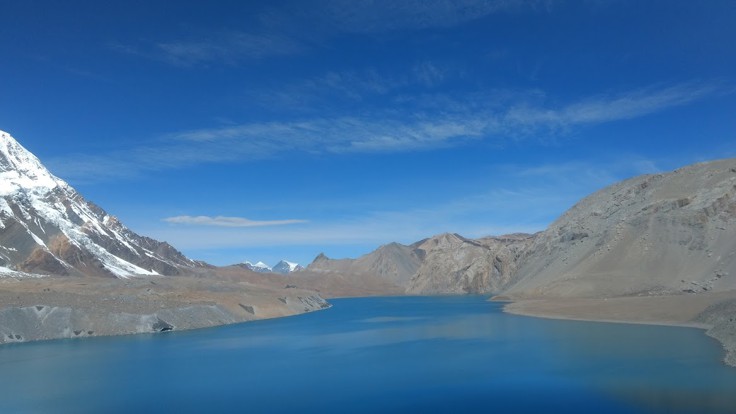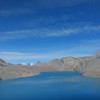Tilicho Lake Short trek - 11 Days
Unknown
N/A
Flexible Cancellation Policy & Fair Prices
N/A
N/A
Flexible Cancellation Policy & Fair Prices
N/A
N/A
Flexible Cancellation Policy & Fair Prices
N/A
HIGHLIGHTS
- Stunning Tilicho lake
- Panoramic sceneries of gorgeous Himalayan ranges, monasteries, waterfalls and tiny/huge lakes along the trails.
- Pass through a wide variety of landscapes from lush subtropical forests to barren, mountains.
QUICK FACTS
- Difficulty LevelModerate
- Total LengthNot available
- Highest Altitude4,900 meters
- Elevation ProfileNot available
- Start locationChame
- Finish locationManang
- PermitsACAP permit, TIMS Permit
- Best Seasonanytime other than late December to early March
DAY TO DAY ITINERARY
- Chame
(2,704 m)
- Lower Pisang
(3,200 m)
- Lower Pisang
(3,200 m)
- Manang
(3,540 m)
- Khangsar
(3,740 m)
- Tilicho Base Camp
(4,135 m)
- Tilicho Base Camp
(4,135 m)
- Tilicho
(4,910 m)
- Shree Kharka
( m)
- Shree Kharka
( m)
- Manang
(3,540 m)
DESCRIPTION
Tilicho Lake Trek is one of the most beautiful and exciting short treks one can do in Nepal. It lies in Manang (Annapurna Circuit Region), and a lot of people take it as a side-trip while trekking the Annapurna Circuit. Tilicho lake is a stunning glacial lake with Tilicho peak at an altitude of 4920 meters covering a huge area of 3.5 square kilometers. Most people consider as the highest lake in the world (but actually isn’t), which however doesn’t take away the fact that Tilicho will leave you spellbound. You will experience mountains up close, culture of Manangi people, encounter breathtaking waterfalls, and walk through the wide mountain valley of Manang adorned by variety of flora and fauna.

Good Time to Go: anytime other than late December to early March
Entry Point: Besisahar (6 hours by bus from Kathmandu) Exit Point: Besisahar
Trail condition: The trails are led by the Marshyangdi river as you follow the river all along. Although the complete area is connected by motorable roads, you have options to skip the roads and take off tracks in between by following the trail markers. If you are in short of time, you can cut the journey short by taking a jeep through one of the most dangerous roads to Chame (which will also add an adventurous side to the trek) and start the trek from there. The trail is same as Annapurna Circuit till Shree kharka, from where you take a left turn to Tilicho lake via Khangsar. The motor road ends at Khangsar. The trail from Khangsar to Tilicho Base Camp (for two hours or so) is spine chilling as you will be walking through the landslide area. Then, a stiff uphill through the narrow path awaits to take you to Tilicho.
Accommodation: The lodges all along the trail as basic with decent food and services. As you go higher, you will not find rooms with attached bathroom. In the extreme peak season of October/ November, it is highly likely that you will have to sleep in tent or dining halls as well (if you arrive the place late) in Tilicho Base Camp.
Risks: As you will be reaching the altitude of almost 5000 meters in a few days, it is highly advised that you acclimatize well. Please avoid taking jeep directly to Khangsar. Also, It is advised to avoid the winter as it can get extremely cold followed by heavy snowfall as Mustang lies in the Rain Shadow area. Also, please consider some extra days, as flight cancellation due to bad weather is pretty common.
Route Variations: It is possible to bypass the road by using the New Annapurna Trekking Trail (NATT) marked by the red-white signs throughout the trail. It is also possible to avoid beautiful views and interesting monasteries by skipping on Upper Pisang, Gyau and Ngawal. If you have extra days, you can take several side-trips like Ice lake, Milarepa Cave and Chongkar view point from Manang. You also have the option to exit via Mustang by taking either Mesokanto pass or Tilicho pass (However, it is only advised to go take this path with experienced guides as trails aren’t marked well and it is challenging) from the west of Tilicho lake. See “Trekking In Nepal’ App for more detailed information about villages, trails, side trips and lodges.
Note: If you wish to go on this trek, please fill the inquiry form and we will help you plan your trek according to your preference: https://honeyguideapps.com/onboarding-form
FAQS
Traveling to the mountains poses some inherent risks. As such, the best strategy is to prepare for the worst and then hope for the best.
PRE-EXISTING CONDITIONS
The first thing to keep in mind is to see if you have pre-existing conditions that could cause complications at high altitudes. Specifically, suppose you have sickle cell disease, pulmonary hypertension, obesity hypoventilation syndrome, or congenital heart problems. In that case, we highly recommend you consult with a qualified physician before planning a trip to the mountains. Read more.
ALTITUDE-ILLNESS
Given the low amount of oxygen at high altitudes, a sensible ascent is essential to give your body the time to acclimate to the thin air. Failure to do so can lead to your lungs or brain filling up with water leading to death in some cases. The key is not to climb more than 500 meters in one day once you pass the 2,500 meters mark. Read more.
ENVIRONMENTAL HAZARDS
Given the extreme weather in the high mountains, proper gear and regimen must have a safe and comfortable tour. The three most important things that you have to prepare for are cold, snow, and radiation. As such, invest in the right sunglasses, sunscreen, boots, and clothing. Read more.
TRAVEL INSURANCE
We highly recommend everyone get travel insurance covering high altitude evacuation before leaving on a trek to the high mountains. Global Rescue and World Nomads are both highly recommended. For Nepali travelers, please note that insurance that covers helicopter rescue is not available as of now. As such, please be careful while planning your tour and only work with companies that can provide timely evacuation service if needed.
RESCUE AND EMERGENCY
As health facilities are limited in the mountains, a helicopter's evacuation is usually the only option during an emergency. As such, the right insurance provider is essential. If you are not buying insurance for some reason, please ensure that there is someone in Kathmandu who can coordinate payments for a helicopter rescue. Here are some other contacts that might come in handy during an emergency. If you still have questions, please feel free to call / whatsapp us at +977-9801916215 or email Ashish at nectar@honeyguideapps.com
HOW DO I MAKE A PAYMENT?
To confirm your tour, you will have to make complete payment either through one of your integrated payment gateways or transfer the funds to the following bank accounts:
For Nepali citizens:
Account Name:: HoneyGuide Pvt. Ltd. Beneficiary Bank: Himalayan Bank, Patan Branch Account Number: 00606903770018For Indian Citizens:
For USD transfers
Account Name: HoneyGuide Apps, Inc. Bank Name: Silicon Valley Bank Account Number: 3302225311 Swift Code: SVBKUS6S ABA Routing Number: 121140399BOOKING A TOUR
Deposit Required for Reservation: 50 percent of total tour cost Deadline for Full Payment: 2 weeks before the tour begins
CHANGING A TOUR
Two weeks before tour date: No extra charge 1 to 2 weeks before tour date: 10% additional charge Two days to 1 week between tour date: 20% additional charge Within two days of tour date: Above 30% (variable)
CANCELLING A TOUR
Two weeks before tour date: No charge (transaction charges may apply) One to two weeks before tour date: 20% Cancellation Charge Two days to one week between tour date: 50% Cancellation Charge Within two days of tour date: No Refund.
DELAYS AND CHANGES DURING THE TOUR
In case of flight delays/cancellations due to bad weather or unforeseen circumstances, HoneyGuide will change the dates at no additional costs. However, any extra cost incurred, including but not limited to accommodation and food, will be the responsibility of the traveler.
In case of changes due to the trekker's health issues, HoneyGuide will make all the changes without any additional cost. However, any extra charge because of the changes will be the responsibility of the traveler.
While Nepal's mountains see six seasons, the best period to go to the mountains is from March-May and September-December. However, every season has its quirk, just like people. So keep reading to find your match.
For those going to Everest Region, do check out the Best time to go to Everest post.
January/February (Winter)
January/February is a good time for trekkers willing to brave the cold and snow for empty trails, fantastic mountain views, and wildlife sightings.
March/April (Spring)
This is a period that offers a little bit of everything: a little bit of mountain view, a little bit of warm weather, a little bit of flowers, a little bit of crowd, and a whole lot of fun.
May/June (Summer)
This is the best time for those into nature. The flowers are quite something this time of the year, and the bird activity is fantastic. The monsoon hasn't started, and as such, mornings are still clear with beautiful mountain views.
July/August (Monsoon)
Only for hardcore trekkers who are willing to put up with the elements for an authentic cultural experience and high altitude flowers. Also, flight disruptions are very likely, and chances of mountain views are close to zero.
September/October (Fall)
This period is everyone's darling, and the trails are as crowded as they can be. The mountain views are something to write home about, and the temperature is just perfect.
November/December (Pre-Winter)
Another popular period among trekkers and the driest two months in the calendar. Indeed it has gotten a bit nippy during the mornings and evenings, but it is still manageable. Count on a lot of sunshine and crystal clear mountain views.




